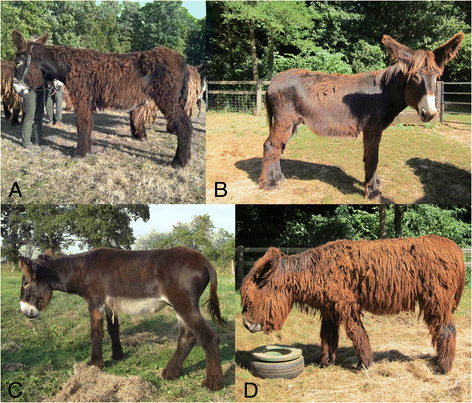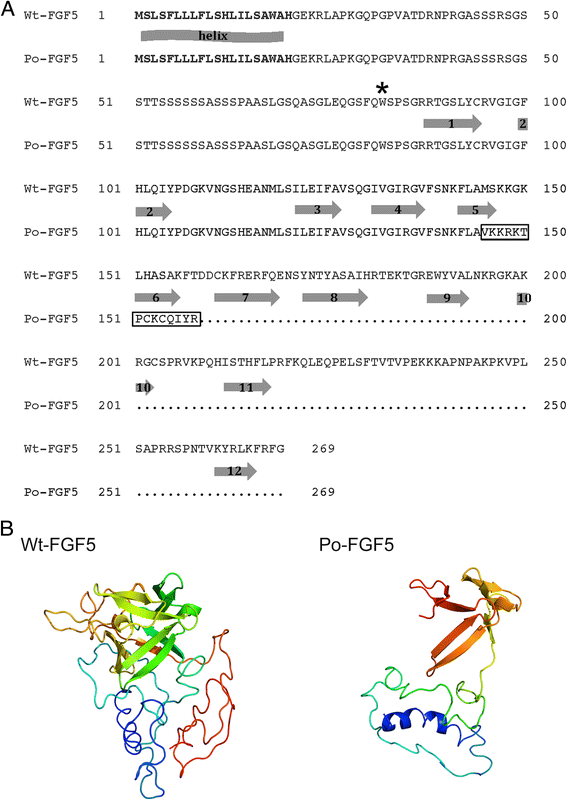Two recessive mutations in FGF5 are associated with the long-hair phenotype in donkeys
- PMID: 25927731
- PMCID: PMC4175617
- DOI: 10.1186/s12711-014-0065-5
Two recessive mutations in FGF5 are associated with the long-hair phenotype in donkeys
Abstract
Background: Seven donkey breeds are recognized by the French studbook. Individuals from the Pyrenean, Provence, Berry Black, Normand, Cotentin and Bourbonnais breeds are characterized by a short coat, while those from the Poitou breed (Baudet du Poitou) are characterized by a long-hair phenotype. We hypothesized that loss-of-function mutations in the FGF5 (fibroblast growth factor 5) gene, which are associated with a long-hair phenotype in several mammalian species, may account for the special coat feature of Poitou donkeys. To the best of our knowledge, mutations in FGF5 have never been described in Equidae.
Methods: We sequenced the FGF5 gene from 35 long-haired Poitou donkeys, as well as from a panel of 67 short-haired donkeys from the six other French breeds and 131 short-haired ponies and horses.
Results: We identified a recessive c.433_434delAT frameshift deletion in FGF5, present in Poitou and three other donkey breeds and a recessive nonsense c.245G > A substitution, present in Poitou and four other donkey breeds. The frameshift deletion was associated with the long-hair phenotype in Poitou donkeys when present in two copies (n = 31) or combined with the nonsense mutation (n = 4). The frameshift deletion led to a stop codon at position 159 whereas the nonsense mutation led to a stop codon at position 82 in the FGF5 protein. In silico, the two truncated FGF5 proteins were predicted to lack the critical β strands involved in the interaction between FGF5 and its receptor, a mandatory step to inhibit hair growth.
Conclusions: Our results highlight the allelic heterogeneity of the long-hair phenotype in donkeys and enlarge the panel of recessive FGF5 loss-of-function alleles described in mammals. Thanks to the DNA test developed in this study, breeders of non-Poitou breeds will have the opportunity to identify long-hair carriers in their breeding stocks.
Figures


Similar articles
-
Allelic heterogeneity of FGF5 mutations causes the long-hair phenotype in dogs.Anim Genet. 2013 Aug;44(4):425-31. doi: 10.1111/age.12010. Epub 2013 Feb 6. Anim Genet. 2013. PMID: 23384345
-
Mutations within the FGF5 gene are associated with hair length in cats.Anim Genet. 2007 Jun;38(3):218-21. doi: 10.1111/j.1365-2052.2007.01590.x. Epub 2007 Apr 13. Anim Genet. 2007. PMID: 17433015
-
A missense mutation in melanocortin 1 receptor is associated with the red coat colour in donkeys.Anim Genet. 2014 Dec;45(6):878-80. doi: 10.1111/age.12207. Epub 2014 Aug 25. Anim Genet. 2014. PMID: 25155046
-
FGF5.Differentiation. 2024 Sep-Oct;139:100736. doi: 10.1016/j.diff.2023.10.004. Epub 2023 Nov 7. Differentiation. 2024. PMID: 37957094 Review.
-
A Fast PCR Test for the Simultaneous Identification of Species and Gender in Horses, Donkeys, Mules and Hinnies.J Equine Vet Sci. 2021 Jul;102:103458. doi: 10.1016/j.jevs.2021.103458. Epub 2021 Apr 27. J Equine Vet Sci. 2021. PMID: 34119210 Review.
Cited by
-
The Genetic Diversity of Stallions of Different Breeds in Russia.Genes (Basel). 2023 Jul 24;14(7):1511. doi: 10.3390/genes14071511. Genes (Basel). 2023. PMID: 37510415 Free PMC article.
-
Cdrom Archive: A Gateway to Study Camel Phenotypes.Front Genet. 2019 Feb 5;10:48. doi: 10.3389/fgene.2019.00048. eCollection 2019. Front Genet. 2019. PMID: 30804986 Free PMC article. Review.
-
Regulation of Hair Follicle Growth and Development by Different Alternative Spliceosomes of FGF5 in Rabbits.Genes (Basel). 2024 Mar 26;15(4):409. doi: 10.3390/genes15040409. Genes (Basel). 2024. PMID: 38674344 Free PMC article.
-
Crosstalk between androgen and Wnt/β-catenin leads to changes of wool density in FGF5-knockout sheep.Cell Death Dis. 2020 May 29;11(5):407. doi: 10.1038/s41419-020-2622-x. Cell Death Dis. 2020. PMID: 32472005 Free PMC article.
-
Generation of gene-modified goats targeting MSTN and FGF5 via zygote injection of CRISPR/Cas9 system.Sci Rep. 2015 Sep 10;5:13878. doi: 10.1038/srep13878. Sci Rep. 2015. PMID: 26354037 Free PMC article.
References
-
- Ozawa K, Suzuki S, Asada M, Tomooka Y, Li AJ, Yoneda A, Komi A, Imamura T. An alternatively spliced fibroblast growth factor (FGF)-5 mRNA is abundant in brain and translates into a partial agonist/antagonist for FGF-5 neurotrophic activity. J Biol Chem. 1998;273:29262–29271. doi: 10.1074/jbc.273.44.29262. - DOI - PubMed
Publication types
MeSH terms
Substances
Associated data
- Actions
- Actions
- Actions
LinkOut - more resources
Full Text Sources
Other Literature Sources

